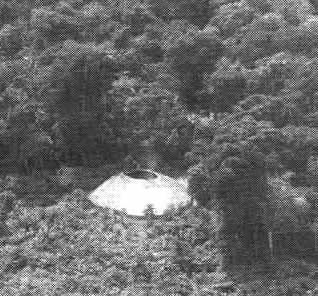Yanomamo Religion: The Cosmos
From: Yanomamo, Fifth Edition (1997)by Napoleon Chagnon (Harcourt Brace & Company, Orlando, Florida)
The Yanomamo conceive of the cosmos as comprising at least four parallel layers, each lying horizontally and separated by a vague but relatively small space. The layers are like inverted dinner plates: gently curved, round, thin, rigid, and having a top and a bottom surface....
The uppermost layer of the four (there might be more according to some Yanomamo) is thought to be 'pristine' or 'tender': duku ka misi. At present this layer is empty or void (broke), but many things had their origin there in the distant past. Things tend to move downward in the Yanomamo cosmos, falling or descending to a lower layer. Sometimes the uppermost layer is described with the term 'old woman', as are abandoned, nonproducing gardens...

Graphic Depiction of Yanomamo Cosmos, from Lenkeit Cultural Anthropology, 1st Ed., p.174
The next layer down is called hedu ka misi: the 'sky' layer. The upper surface of hedu is invisible to us, but is believed to be similar to what we know on earth--it has trees, gardens, villages, animals, plants, and most important, the souls [one of them] of deceased Yanomamo who are in some sense similar to mortal men. They garden, hunt, make love, eat, and practice witchcraft on each other. Everything that exists on earth has its replica or counterpart in hedu, as if hedu were a mirror image of life as mortals know it. [The 'sky' layer could be considered the Yanomamo equivalent of the Christian heaven, except that one soul of all Yanomamo goes to this layer after death, where for immortality they live a life almost exactly like the Yanomamo on earth. Perhaps Christians would not be so interested in going to heaven if they thought it would be exactly like life on earth!]
The bottom surface of hedu is what we on earth can actually see with our eyes: the visible 'sky'. Stars and planets are somehow or other 'stuck' onto this layer and move across it along their individual trails, east to west. Some Yanomamo think the stars are fish, but they have a generally undeveloped set of astronomical ideas about the stars and planets and nothing that we would call named constellations. The bottom of hedu is conceived to be relatively close to earth, for I repeatedly was asked if I bumped into it when I took rides in airplanes.
Man--Yanomamo--dwells on 'this layer': hei ka misi. 'This layer' was created when a chunk of hedu broke off and fell downward. As all can plainly see, 'this layer' is characterized by jungle, rivers, hills, animals, plants, gardens, and so on, and is covered with people who are essentially slightly different variants of Yanomamo--speaking a dialect of Yanomamo that is 'wrong' or 'crooked'. Even 'foreigners' ... are thought to dwell in shabonos [the Yanomamo communal house, see below], for foreigners are simply degenerate copies of real humans--Yanomamo. In fact the Yanomamo thought I was a 'reincarnated' version of them and would ask me frequently if I had 'drowned' and had come back to life. The reason for this question was that in one of their myths, a great flood occurred and some Yanomamo escaped death by grabbing onto logs. They floated downstream and were not seen again and presumably most of them drowned. Some now return, floating on logs (canoes), look different and speak 'crooked'--foreigners. A spirit named Omawa fished them out of the water downstream, wrung them out, made them come to life again and sent them back 'home'.

A Yanomamo village from the air: a communal Shabono, with gardens in foreground. From Yanomamo, 5th Ed., by Chagnon, p.57
Finally, the surface below 'this layer', hei ta bebi, is almost barren. A peculiar [supernatural] variant of Yanomamo live there, a people called Amahiri-teri.They originated a long time ago when a piece of hedu broke off and crashed to 'this layer', knocking a hole in it and continuing downward. It hit 'this layer' at a place where the Amahiri-teri lived, carrying them and their village downward to the new layer. Unfortunately, just the garden and shabono of the Amahiri-teri was carried downward and not their jungle, where they hunted. Thus, they have no game animals and have changed into cannibals: They sent their spirits upward, to 'this layer', to capture the souls of children, which are carried down to their village and eaten. [This is one of the major causes of illness in the Yanomamo culture: soul loss due to kidnapping by the supernatural Amahiri-teri.] In some Yanomamo villages the shamans contest regularly with the Amahiri-teri, attempting to thwart their cannibalistic incursions...
The Amahiri-teri people lived at the time of the no badabo, the original humans. These original humans were distinct from living Man in that they were part spirit and part human, and most were also part animal--the myths frequently explain how this transformation occurred. When the original people died, they turned into spirits: hekura. The term no badabo means 'those who are now dead'. In the context of myth and stories of the cosmos, it means the 'original humans' or 'those who were here in the beginning of time.'
|